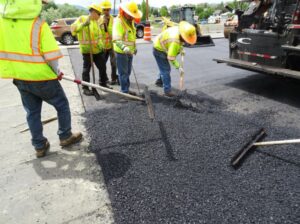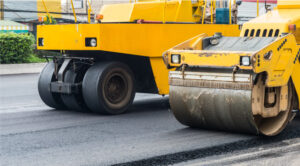Home » Posts tagged 'asphalt paving'
Tag Archives: asphalt paving
Advantages of Asphalt Paving
Asphalt is the pavement of choice for highways, roads, streets and parking lots in virtually every country. It is highly versatile, durable and cost effective.

The quality of asphalt pavement is important. For example, the base course needs to distribute traffic and environmental loads to reduce rutting by providing stability and durability. It also must have a high stiffness to resist deformation.
Asphalt is a lot cheaper than concrete, which means you can save money on the initial cost of the project. It also requires less maintenance over time and is more environmentally friendly. Plus, it is smoother to drive on, which can help reduce noise pollution and wear and tear on vehicles. If you want to reduce the level of traffic noise even more, you can use rubberized asphalt. This type of pavement is made from recycled tires, which would otherwise be thrown away.
The process of paving with asphalt is very quick, which allows for minimal downtime for businesses. This is especially important for commercial locations, as it keeps employees and customers safe and comfortable while they’re in the office or on the road. It’s also faster than other paving materials, such as concrete, which can take weeks to cure before they are ready for use.
Most asphalt is produced as a hot mix, which is heated to 350°F. This is the most popular form of asphalt, and it’s used for high-traffic roadways and highways. Cold mix is also available, which is mixed at lower temperatures and uses less fuel.
Another option for reducing the environmental impact of asphalt is using recycled aggregates. These are usually sourced from local roads, but they can also be obtained from airport runways and other sources. The material is then ground and mixed into new asphalt to create a mixture that is similar to the original. This helps to reduce the amount of waste that is produced and can contribute to greenhouse gas emissions.
An asphalt paving company can help you determine the best type of asphalt for your needs. They will take into account the amount of traffic, such as cars or heavy trucks, and the type of surface you need. It’s also important to consider the climate, as asphalt can be affected by moisture and temperature extremes.
During the paving process, the asphalt is mixed with additives to achieve the desired density. These additives can include recycled frying oil, residue from corn stover and treated swine manure. However, the addition of these soft materials reduces the high-temperature grade of the asphalt, which increases its rutting resistance and decreases its lifespan.
Durability
Asphalt is a durable, long-lasting material that is suitable for roads and other large paving projects. It is easier to maintain than concrete, and is available in a range of colors and styles. It is also environmentally friendly, as it can be recycled after use and reused in other applications. The durability of asphalt can be improved by reducing air voids and increasing density. This will increase the fatigue life of the pavement and reduce maintenance costs.
The asphalt paving industry is working to improve the longevity of their materials and has adopted a new standard that requires higher density specifications for all paved surfaces. This standard aims to minimize the risk of distresses that require full-depth repairs, while at the same time maximizing the amount of traffic the pavement can handle. The higher the density of an asphalt pavement, the less likely it is to crack or rut.
One of the most important factors in determining the durability of asphalt is its constructability, or how well it can be constructed. This is especially important for highways and other heavy-duty projects. When constructing these types of projects, it is essential that the asphalt is able to be placed and compacted quickly. This allows construction crews to keep traffic moving, and provides a safer work environment for the construction workers.
Another factor in the durability of asphalt is its ability to resist damage from climate and other environmental conditions. For example, wet weather can cause the pavement to become brittle. This can lead to premature failure. In addition, water underneath the pavement can weaken the structure and cause the road to collapse. This can be caused by a drainage problem, or by a rising water table.
The durability of asphalt is enhanced by a proper design and construction process. A properly designed pavement is constructed with a thick base course that bears the main load, followed by a strong-load bearing intermediate course and finally, a 30-40 mm surface course. When these layers are built correctly, they can last decades without requiring a total reconstruction.
Safety
Asphalt roads serve a vital function in modern society, providing increased mobility for people and goods. However, they also require careful maintenance to ensure optimal safety and durability. Fortunately, new advances in asphalt technology allow for the construction and repair of roadways at a reduced cost and with less impact on motorists. These innovations are especially important for rural routes, which have limited access to alternative transportation options.
Roads must be able to handle the stress and strain of heavy vehicles, while at the same time meeting noise reduction and comfort requirements. To accomplish this, they need to have high stiffness and resistance to deformation. In addition, they must be able to support varying loads and weather conditions. The best way to achieve this is to use a combination of high quality aggregates and an innovative paving technique, such as warm mix asphalt.
Hot asphalt is a dangerous material for workers to work with, but this danger can be minimized by using proper PPE. This includes a face shield and chemical goggles to protect the eyes and body from sprays, fumes, and hot asphalt. It also includes thermally insulated gloves to prevent burns and solvent-soaked skin. Long-sleeved shirts, pants, or coveralls should be worn with these gloves to further protect the skin. Footwear should include safety toes and boots with a six-inch top or higher.
Workers should also be hydrated, even during summer temperatures. Drinking 16 ounces of water or electrolyte beverage per hour can help reduce the risk of heat exhaustion or heat stroke. Also, it is important to eat a healthy meal before starting work. Workers should also wash their hands frequently and thoroughly.
Other important safety measures include checking equipment before each shift to ensure that all parts are functioning properly and that they have been cleaned. Workers should also follow lockout/blockout procedures and turn off machinery before leaving the operator’s station. Finally, workers should never smoke or consume food near the asphalt. This will help to avoid any contaminants from leaking into the paving process and exposing workers to additional health risks.
Maintenance
Asphalt, also known as blacktop, is a popular choice for roads and parking lots because it provides a safe and durable surface that is easy to maintain. Whether you need to repair cracks, fill potholes, or sealcoat your asphalt pavement, it’s important to use high-quality materials and tools for the job. It’s also a good idea to wear safety equipment like gloves and safety glasses and to place warning signs or barricades around the area where you’re working.
In addition to regular inspections, asphalt maintenance requires regular cleaning and patching to ensure the longevity of your asphalt pavement. This process includes sweeping the surface and using a blower to remove dirt, leaves, debris, and oil spills. You should always check the weather before beginning any maintenance work, as harsh conditions can speed up damage to your pavement.
Some of the most common types of maintenance required for asphalt include the repainting of lot lines and the repair of cracks and potholes. These minor repairs can be done with a broom, a crack sealer, or by removing and refilling these damaged areas. You should also monitor traffic patterns to help prevent the need for large-scale paving projects.
Another type of maintenance is a cold mix overlay, which involves using radiated heat to soften existing asphalt and then adding additional hot mix. This is a fast and cost-effective way to repair small patches, ruts, and other issues with asphalt surfaces. However, it is not recommended for structural repairs or areas with base failure.
A major cause of asphalt damage is vehicle stress, which can lead to rutting, troughs, and corrugations. This damage is often caused by slow-moving vehicles, which cause the road to flex over long periods of time and result in fatigue cracking and crocodile cracking.
If you’re looking for a cost-effective and durable way to keep your parking lot or driveway in good shape, consider investing in preventative asphalt maintenance. This will help you avoid costly repaving projects and extend the life of your asphalt. Taking the time to perform small repairs as soon as you notice them can save you thousands in the long run.
